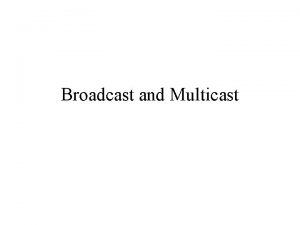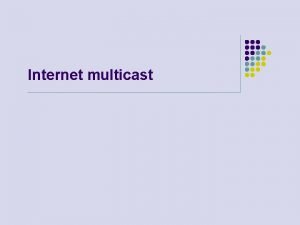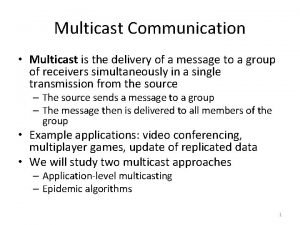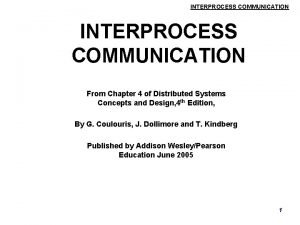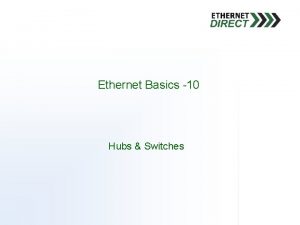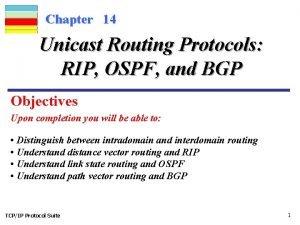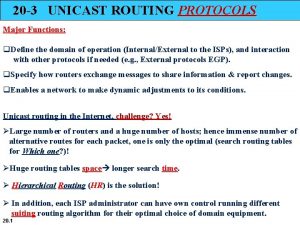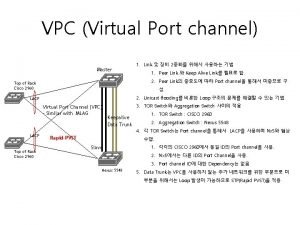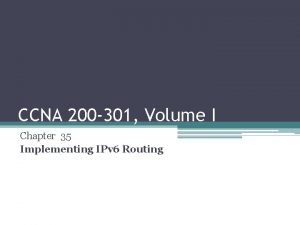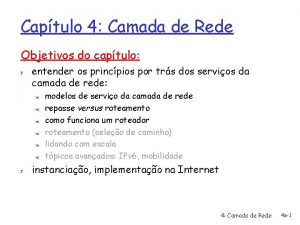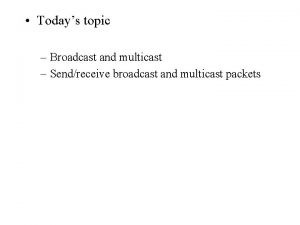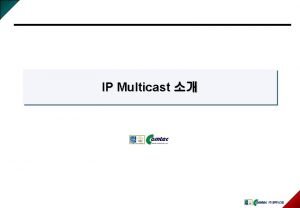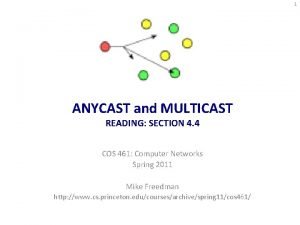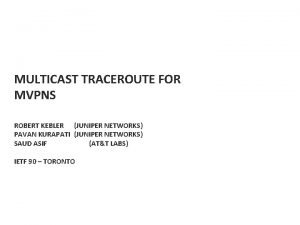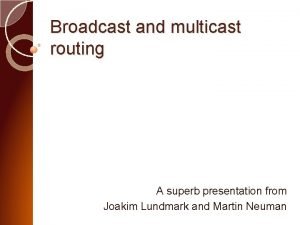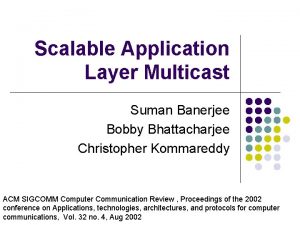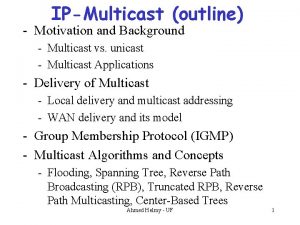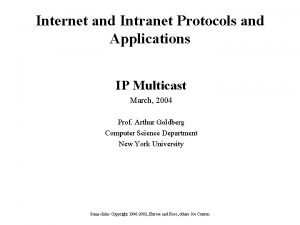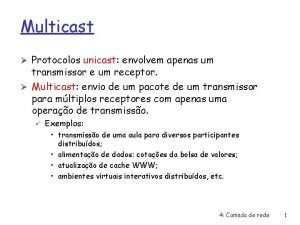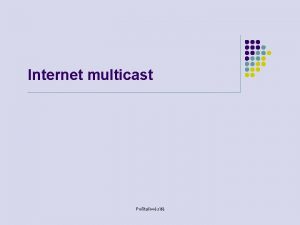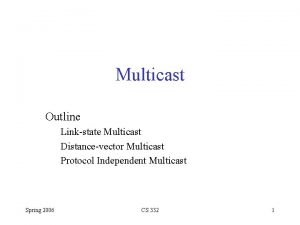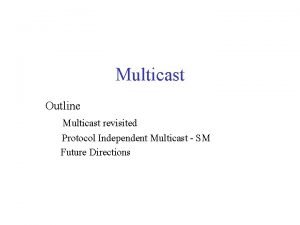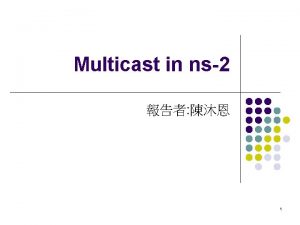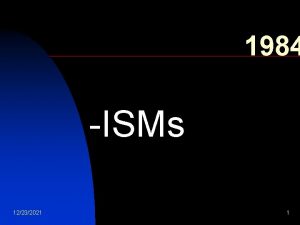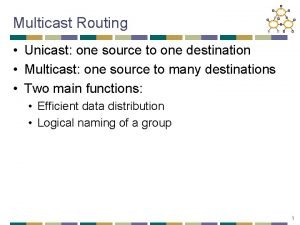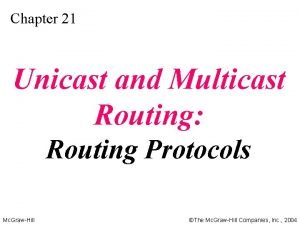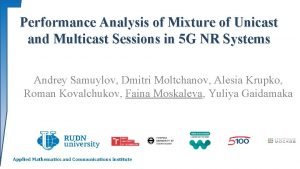Group Communication 12232021 1 Unicast vs Multicast 12232021












































- Slides: 44

Group Communication 12/23/2021 1

Unicast vs. Multicast 12/23/2021 2

Multicast Whereas the majority of network services and network applications use unicast for IPC, multicasting is useful for applications such as groupware, online conferences, interactive distance learning, and can be used for applications such as online auction. It can also be used in replication of services for fault tolerance. 12/23/2021 3

Multicast group In an application or network service which makes use of multicasting, a set of processes forms a group, called a multicast group. Each process in a group can send and receive messages. A message sent by any process in the group can be received by each participating process in the group. A process may also choose to leave a multicast group. In an application such as online conferencing, a group of processes interoperate using multicasting to exchange audio, video, and/or text data. 12/23/2021 4

An Archetypal Multicast API Primitive operations: Join – This operation allows a process to join a specific multicast group. A process that has joined a multicast group is a member of the group and is entitled to receive all multicast addressed to the group. A process should be able to be a member of multiple multicast groups at any time. Note that for this and other multicast operations, a naming scheme is needed to uniquely identify a multicast group. (e. g. , Multicast. Socket: join. Group(Inet. Address mcastaddr)) 12/23/2021 5

Multicast API Operations - continued Leave –This operation allows a member process to stop participating in a multicast group. A process that has left a multicast group is no longer a member of the group and is thereafter not entitled to receive any multicast addressed to the group, although the process may remain a member of other multicast groups. (e. g. , Multicast. Socket: leave. Group(Inet. Address mcastaddr)) 12/23/2021 6

Multicast API Operations - continued Send – This operation allows a member process to send a message to all processes currently participating in a multicast group. (e. g. , Multicast. Socket: send()) Receive –This operation allows a member process to receive messages sent to a multicast group. (e. g. , Multicast. Socket: receive()) 12/23/2021 7

Multicast Delivery When a multicasting message is sent by a process, the runtime support of the multicast mechanism is responsible for delivering the message to each process currently in the multicast group. As each participating process may reside on a separate host, the delivery of these messages requires the support of mechanisms running independently on those systems. Due to factors such as failures of network links and/or network hosts, routing delays, and differences in software and hardware, the timing between when a multicast message is sent and when it is received may vary among the recipient processes. 12/23/2021 8

Multicast Delivery A message may not be received by one or more of the processes at all, due to errors and/or failures in the network, the machines, or the runtime support. Some applications, such as video conferencing, can tolerate an occasional miss or misordering of messages, there applications – such as database applications – for which such anomalies are unacceptable. 12/23/2021 9

Classification of multicasting mechanisms in terms of message delivery Unreliable multicast: At its most basic, a multicast system will make a good-faith/best attempt to deliver messages to each participating process, but the arrival of the correct message at each process is not guaranteed. In the best case, the message is received by all processes. In the worst case, the message may be received by none. In other cases, the message may be received by some but not all, or the messages may be received by some processes in a corrupted form. Such a system is said to provide unreliable multicast. 12/23/2021 10

Classification of multicasting mechanisms in terms of message delivery - 2 Reliable multicast: A multicast system which guarantees that each message is eventually delivered to each process in the group is said to provide reliable multicast. In such a system, each message sent by a process can be assumed to be delivered in a non-corrupted form to all processes in the group eventually. 12/23/2021 11

Classification of multicasting mechanisms in terms of message delivery - 3 The definition of reliable multicast requires that each participating process receives exactly one copy of each message sent. However, the definition places no restriction on the order that the messages are delivered to each process Each process may receive the messages in any permutation of those messages. For applications where the order of message delivery is significant, it is helpful to further classify reliable multicast systems based on the order of the delivery of messages. 12/23/2021 12

Classification of reliable multicast Unordered An unordered reliable multicast system guarantees the safe delivery of each message, but it provides no guarantee on the delivery order of the messages. Example: Processes P 1, P 2, and P 3 have formed a multicast group. Further suppose that three messages, m 1, m 2, m 3 have been sent to the group. Then an unordered reliable multicast system may deliver the messages to each of the three processes in any of the 3! = 6 permutations (m 1 -m 2 m 3, m 1 -m 3 -m 2, m 2 -m 1 -m 3, m 2 -m 3 -m 1, m 3 -m 1 -m 2, m 3 -m 2 -m 1). Note that it is possible for each participant to receive the messages in an order different from the orders of messages delivered to other participants. 12/23/2021 13

Classification of reliable multicast - 2 FIFO multicast A system which guarantees that the delivery of the messages adhere to the following condition is said to provide FIFO (first-in-first-out) or send-order multicast: If process P sent messages mi and mj, in that order, then each process in the multicast group will be delivered the messages mi and mj, in that order. Suppose P 1 sends messages m 1, m 2, and m 3 in order, then each process in the group is guaranteed to have those messages delivered in that same order: m 1, m 2, then m 3. 12/23/2021 14

Classification of reliable multicast - 2 FIFO multicast places no restriction on the delivery order among messages sent by different processes. Simplified example of a multicast group of two processes: P 1 and P 2. Suppose P 1 sends messages m 11 then m 12, while P 2 sends messages m 21 then m 22. Then a FIFO multicast system can deliver the messages to each of the two processes in any of the following orders: m 11 -m 12 -m 21 -m 22, m 11 -m 21 -m 12 -m 22, m 11 -m 22 -m 12, m 21 -m 12 -m 22 m 21 -m 11 -m 22 -m 12 m 21 -m 22 -m 11 -m 12. 12/23/2021 15

Classification of reliable multicast - 3 Causal Order Multicast A multicast system is said to provide causal multicast if its message delivery satisfies the following criterion: If message mi causes (results in) the occurrence of message mj, then mi will be delivered to each process prior to mj. Messages mi and mj are said to have a causal or happenbefore relationship, denoted mi -> mj. The happen-before relationship is transitory: if mi -> mj and mj -> mk, then mi -> mj -> mk. In this case, a causalorder multicast system guarantees that these three messages will be delivered to each process in the order of mi, mj, then mk. 12/23/2021 16

Causal Order Multicast – example 1 Suppose three processes P 1, P 2, and P 3 are in a multicast group. P 1 sends a message m 1, to which P 2 replies with a multicast message m 2. Since m 2 is triggered by m 1, the two messages share a causal relationship of m 1 -> m 2. Suppose the receiving of m 2 in turn triggers a multicast message m 3 sent by P 3, that is, m 2 -> m 3. The three messages share the causal relationship of m 1 -> m 2 -> m 3. A causal-order multicast message system ensures that these three messages will be delivered to each of the three processes in the order of m 1 - m 2 - m 3. 12/23/2021 17

Causal Order Multicast – example 2 Suppose P 1 multicasts message m 1, to which P 2 replies with a multicast message m 2, and independently P 3 replies to m 1 with a multicast message m 3. The three messages now share these causal relationships: m 1 -> m 2 and m 1 -> m 3. A causal-order multicast system can delivery these message in either of the following orders: m 1 - m 2 - m 3 m 1 - m 3 - m 2 In such a system, it is not possible for the messages to be delivered to any of the processes in any other permutation of the three messages, such as m 2 - m 1 - m 3 or m 3 - m 1 - m 2, the first of these violates the causal relationship m 1 -> m 2 , while the second permutation violates the causal relationship m 1 -> m 3. 12/23/2021 18

Classification of reliable multicast - 4 Atomic order multicast In an atomic-order multicast system, all messages are guaranteed to be delivered to each participant in the exact same order. Note that the delivery order does not have to be FIFO or causal, but must be identical for each process. Example: P 1 sends m 1, P 2 sends m 2, and P 3 sends m 3. An atomic system will guarantee that the messages will be delivered to each process in only one of the six orders: m 1 -m 2 - m 3, m 1 - m 3 - m 2, m 2 - m 1 -m 3, m 2 -m 3 -m 1, m 3 -m 1 - m 2, m 3 -m 2 -m 1. 12/23/2021 19

Atomic Multicast Example P 1 sends m 1 then m 2. P 2 replies to m 1 by sending m 3. P 3 replies to m 3 by sending m 4. the sequence of the events dictates that P 1 must be delivered m 1 before sending m 2. Likewise, P 2 must receive m 1 then m 3, while P 3 must receive m 3 before m 4. Hence any atomic delivery order must preserve the order m 1 m 3 m 4. The remaining message m 2 can, however, be interleaved with these messages in any manner. Thus an atomic multicast will result in the messages being delivered to each of the processes in one of the following orders: m 1 - m 2 - m 3 - m 4 , m 1 - m 3 m 2 - m 4 , or m 1 - m 3 - m 4 - m 2. 12/23/2021 20

The Java Basic Multicast API At the transport layer, the basic multicast supported by Java is an extension of UDP ( User Datagram Protocol), which is connectionless and unreliable. For the basic multicast, Java provides a set of classes which are closely related to the datagram socket API classes. 12/23/2021 21

The Java Basic Multicast API - 2 There are four major classes in the API, the first three of which we have already seen in the context of datagram sockets. 1. Inet. Address: In the datagram socket API, this class represents the IP address of a sender or a receiver. In multicasting, this class can be used to identify a multicast group (see next section). 2. Datagram. Packet: As with datagram sockets, an object of this class represents an actual datagram; in multicast, a Datagram. Packet object represents a packet of data sent to all participants or received by each participant in a multicast group. 12/23/2021 22

The Java Basic Multicast API - 3 3. Datagram. Socket: In the datagram socket API, this class represents a socket through which a process may send or receive data. 4. Multicast. Socket : A Multicast. Socket is a subclass of Datagram. Socket, with additional capabilities for joining and leaving a multicast group. An object of the multicast datagram socket class can be used for sending and receiving IP multicast packets. 12/23/2021 23

IP Multicast addresses Instead of a single process, a multicast datagram is meant to be received by all the processes that are currently members of a specific multicast group. Hence each multicast datagram needs to be addressed to a multicast group instead of an individual process. The Java multicast API uses the Internet Protocol (IP) multicast addresses for identifying multicast groups. In IPv 4 multicast group is specified by (i) a class D IP address combined with (ii) a valid port number. 12/23/2021 24

The Internet addressing scheme In IP Version 4, each address is 32 bit long. The address space accommodates 232 (4. 3 billion) addresses in total. Addresses are divided into 5 classes (A through E) 12/23/2021 25

IP Multicast addresses - 2 Class D IP addresses are those with the prefix bit string of 1110, and hence these addresses are in the range of 224. 0. 0. 0 to 239. 255, inclusive. Excluding the four prefix bits, there are 32 -4=28 remaining bits, resulting in an address space of 228; that is, approximate 268 million class D addresses are available, although the address 224. 0. 0. 0 is reserved and should not be used by any application. IPv 4 multicast addresses are managed and assigned by the Internet Assigned Numbers Authority (IANA —www. iana. org). 12/23/2021 26

IP Multicast addresses - 3 1. 2. 3. An application which uses the Java multicast API must specify at least one multicast address for the application. To select a multicast address for an application, there are the following options: Obtain a permanently assigned static multicast address from IANA: Permanent addresses are limited to global, wellknown Internet applications, and their allocations are highly restricted. Choose an arbitrary address, assuming that the combination of the random address, or Obtain a transient multicast address at runtime; such an address can be received by an application through the Session Announcement Protocol (SAP). SAP Ref: http: //www. cs. ucl. ac. uk/staff/jon/mmbook/node 184. html 12/23/2021 27

IP Multicast addresses - 4 Some of the most interesting of the assigned addresses: 224. 0. 0. 1 All Systems on this Subnet 224. 0. 0. 11 Mobile-Agents 224. 0. 1. 84 jini-announcement 224. 0. 1. 85 jini-request 224. 0. 1. 115 Simple Multicast 224. 0. 6. 000 -224. 0. 6. 127 Cornell ISIS Project 224. 0. 7. 000 -224. 0. 7. 255 Where-Are-You 224. 0. 8. 000 -224. 0. 8. 255 INTV 224. 0. 9. 000 -224. 0. 9. 255 Invisible Worlds 224. 0. 12. 000 -224. 0. 12. 063 Microsoft and MSNBC 224. 0. 16. 000 -224. 0. 16. 255 Xing. Net 224. 0. 18. 000 -224. 0. 18. 255 Dow Jones 224. 0. 19. 000 -224. 0. 19. 063 Walt Disney Company 224. 0. 22. 000 -224. 0. 22. 255 WORLD MCAST 224. 2. 0. 0 -224. 2. 127. 253 Multimedia Conference Calls Ref: http: //www. iana. org/assignments/multicast-addresses 12/23/2021 28

IP Multicast addresses - 5 osf 1. gmu. edu: /home/u 2/yhwang 1 > ping 224. 0. 0. 1 PING 224. 0. 0. 1 (224. 0. 0. 1): 56 data bytes 64 bytes from 129. 174. 1. 13: icmp_seq=0 ttl=64 time=5 ms 64 bytes from 129. 174. 1. 110: icmp_seq=0 ttl=64 time=5 ms (DUP!) 64 bytes from 129. 174. 1. 15: icmp_seq=0 ttl=255 time=5 ms (DUP!) 64 bytes from 129. 174. 1. 52: icmp_seq=0 ttl=255 time=6 ms (DUP!) 64 bytes from 129. 174. 1. 86: icmp_seq=0 ttl=255 time=6 ms (DUP!) 64 bytes from 129. 174. 1. 108: icmp_seq=0 ttl=64 time=6 ms (DUP!) 64 bytes from 129. 174. 1. 3: icmp_seq=0 ttl=64 time=6 ms (DUP!) 64 bytes from 129. 174. 1. 187: icmp_seq=0 ttl=255 time=6 ms (DUP!) 64 bytes from 129. 174. 1. 98: icmp_seq=0 ttl=255 time=8 ms (DUP!) 64 bytes from 129. 174. 1. 69: icmp_seq=0 ttl=255 time=8 ms (DUP!) 64 bytes from 129. 174. 1. 94: icmp_seq=0 ttl=255 time=8 ms (DUP!) 64 bytes from 129. 174. 1. 150: icmp_seq=0 ttl=255 time=8 ms (DUP!) 64 bytes from 129. 174. 1. 170: icmp_seq=0 ttl=255 time=8 ms (DUP!) 64 bytes from 129. 174. 1. 68: icmp_seq=0 ttl=255 time=8 ms (DUP!) 64 bytes from 129. 174. 1. 112: icmp_seq=0 ttl=255 time=8 ms (DUP!) 64 bytes from 129. 174. 1. 51: icmp_seq=0 ttl=64 time=8 ms (DUP!) 12/23/2021 29

IP Multicast addresses - 6 A host needs to implements the Internet Protocol (IP) to support multicasting. The range of addresses between 224. 0. 0. 0 and 224. 0. 0. 255, inclusive, is reserved for the use of routing protocols and other low-level topology discovery or maintenance protocols, such as gateway discovery and group membership reporting. Multicast routers should not forward any multicast datagram with destination addresses in the above range, regardless of its time-to-live (TTL). Ref: http: //www. iana. org/assignments/multicast-addresses 12/23/2021 30

IP Multicast addresses - 7 For our examples and exercises, we will make use of the static address 224. 0. 0. 1 for processes running on all machines on the local area network. Or we may use an arbitrary address that has not been assigned, such as a number in the range of 239. *. *. * (for example, 239. 1. 2. 3). In the Java API, a Multicast. Socket object is bound to a valid port number such as 3456, and methods of the object allow for the joining and leaving of a multicast address such as 239. 1. 2. 3 12/23/2021 31

Joining a multicast group To join a multicast group at IP address m and port number p, a Multicast. Socket object must be instantiated with p, then the object’s join. Group method can be invoked specifying the address m: // join a Multicast group at IP address 239. 1. 2. 3 and port 3456 Inet. Address group = Inet. Address. get. By. Name("239. 1. 2. 3"); Multicast. Socket s = new Multicast. Socket(3456); s. join. Group(group); 12/23/2021 32

Sending to a multicast group A multicast message can be sent using syntax similar with the datagram socket API. String msg = "This is a multicast message. "; Inet. Address group = Inet. Address. get. By. Name("239. 1. 2. 3"); Multicast. Socket s = new Multicast. Socket(3456); s. join. Group(group); // optional Datagram. Packet hi = new Datagram. Packet(msg. get. Bytes( ), msg. length( ), group, 3456); s. send(hi); 12/23/2021 33

Receiving messages sent to a multicast group A process that has joined a multicast group may receive messages sent to the group using syntax similar to receiving data using a datagram socket API. byte[] buf = new byte[1000]; Inet. Address group = Inet. Address. get. By. Name("239. 1. 2. 3"); Multicast. Socket s = new Multicast. Socket(3456); s. join. Group(group); // required Datagram. Packet recv = new Datagram. Packet(buf, buf. length); s. receive(recv); 12/23/2021 34

Leaving a multicast group A process may leave a multicast group by invoking the leave. Group method of a Multicast. Socket object, specifying the multicast address of the group. s. leave. Group(group); 12/23/2021 35

Setting the “time-to-live” - 1 The runtime support for a multicast API often employs a technique known as message propagation, whereby a packet is propagated from a host to a neighboring host in an algorithm which, when executed properly, will eventually deliver the message to all the participants. Under some anomalous circumstances, however, it is possible that the algorithm which controls the propagation does not terminate properly, resulting in a packet circulating in the network indefinitely. 12/23/2021 36

Setting the “time-to-live” - 2 Indefinite message propagation causes unnecessary overhead on the systems and the network. To avoid this occurrence, it is recommended that a “time to live” parameter be set with each multicast datagram. The time-to-live (ttl) parameter, when set, limits the count of network links or hops that the packet will be forwarded on the network. 12/23/2021 37

Setting the “time-to-live” - 3 String msg = "Hello everyone!"; Inet. Address group = Inet. Address. get. By. Name("224. 0. 0. 1"); Multicast. Socket s = new Multicast. Socket(3456); s. set. Time. To. Live(1); // set time-to-live to 1 hop – a count // appropriate for multicasting to local hosts Datagram. Packet hi = new Datagram. Packet(msg. get. Bytes( ), msg. length( ), group, 3456); s. send(hi); The value specified for the ttl must be in the range 0 <= ttl <= 255; otherwise, an Illegal. Argument. Exception will be thrown. 12/23/2021 38

Setting the “time-to-live” - 4 The recommended ttl settings are: 0 if the multicast is restricted to processes on the same host 1 if the multicast is restricted to processes on the same subnet 32 if the multicast is restricted to processes on the same site 64 if the multicast is restricted to is processes on the same region 128 if the multicast is restricted to processes on the same continent 255 if the multicast is unrestricted 12/23/2021 39

Multicast program examples Example 1: Example 1 Sender Example 1 Receiver Example 2 Sender. Receiver Read. Thread http: //ise. gmu. edu/~yhwang 1/SWE 622/Sample_Codes/chapter 6 12/23/2021 40

Reliable Multicast API the Java basic Multicast API provides unreliable multicast The Java Reliable Multicast Service (JRM Service) provides the capabilities for a receiver to repair multicast data that are lost or damaged, as well as security measures to protect data privacy. The Totem system, developed by the University of California, Santa Barbara, “provides reliable totally ordered delivery of messages to processes within process groups on a single local-area network, or over multiple local-area networks interconnected by gateways. ” TASC’s Reliable Multicast Framework (RMF) provides reliable and send ordered (FIFO) multicast. Totem Ref : http: //citeseer. ist. psu. edu/agarwal 95 reliable. html 12/23/2021 41

Summary - 1 Unicast vs. multicast: unicast is one-to-one communication, while multicast is one-to-many communication. An archetypal multicast API must provide operations for joining a multicast group, leaving a multicast group, sending to a group, and receiving multicast messages sent to a group. Basic multicast is connectionless and unreliable; in an unreliable multicast system, messages are not guaranteed to be safely delivered to each participant. 12/23/2021 42

Summary - 2 A reliable multicast system ensures that each message sent to a multicast group is delivered correctly to each participant. Reliable multicasts can be further categorized by the order of message delivery they support: Unordered multicast may deliver the messages to each participant in any order. FIFO multicast preserves the order of messages sent by each host. Causal multicast preserves causal relationships among the messages. Atomic multicast delivers the messages to each participant in the same order. 12/23/2021 43

Summary - 3 IP multicast addressing uses a combination of a Class D address and a UDP port number. Class D IP addresses are managed and assigned by IANA. A multicast application may use a static Class D address, a transient address obtained at run time, or an arbitrary unassigned address. The Java basic multicast API provides unreliable multicast. A Multicast. Socket is created with the specification of a port number. The join. Group and leave. Group methods of the Multicast. Socket class, a subclass of Datagram. Socket, can be invoked to join or leave a specific multicast group; and the send and receive methods can be invoked to send and receive a multicast datagram. The Datagram. Pakcet class is also needed to create the datagrams. There are existing packages that provide reliable multicast, including the Java Reliable Multicast Service (JRM Service). 12/23/2021 44
 Multicast vs unicast
Multicast vs unicast Unicast
Unicast Unicast multicast broadcast address example
Unicast multicast broadcast address example Broadcast vs unicast vs multicast
Broadcast vs unicast vs multicast Unicast vs multicast
Unicast vs multicast What is multicast communication in distributed system
What is multicast communication in distributed system Udp datagram communication in distributed system
Udp datagram communication in distributed system Luoyi fu
Luoyi fu Port2port
Port2port Write a detailed note on unicast routing protocols
Write a detailed note on unicast routing protocols What is unicast routing
What is unicast routing Port channel vs vpc
Port channel vs vpc Unicast
Unicast Unicast
Unicast Floating static route
Floating static route Global unicast
Global unicast Broadcasting
Broadcasting What is a characteristic of multicast messages
What is a characteristic of multicast messages Rfp check
Rfp check Anycast vs multicast
Anycast vs multicast Mvpns
Mvpns Overlay multicast
Overlay multicast Multicast
Multicast Order of events
Order of events Broadcast and multicast routing
Broadcast and multicast routing Bobby bhattacharjee
Bobby bhattacharjee Multicast
Multicast Multicast
Multicast Multicast
Multicast Protocolo igmp
Protocolo igmp Bier multicast
Bier multicast Bimodal multicast
Bimodal multicast Calico multicast
Calico multicast Chapter 13 social psychology
Chapter 13 social psychology Within group variance vs between group
Within group variance vs between group Anova within group and between group
Anova within group and between group Types of social groups in sociology
Types of social groups in sociology Jrcptb
Jrcptb Thermal stability of group 2 nitrates
Thermal stability of group 2 nitrates Amino group and carboxyl group
Amino group and carboxyl group Amino group and carboxyl group
Amino group and carboxyl group In group out group
In group out group Group yourselves
Group yourselves William graham sumner in group out group
William graham sumner in group out group Joining together group theory and group skills
Joining together group theory and group skills


